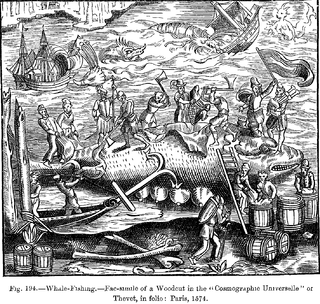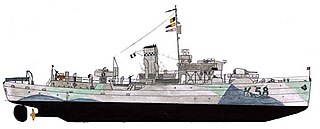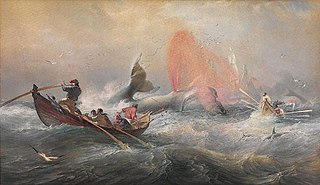
Grytviken is a hamlet on South Georgia in the South Atlantic and formerly a whaling station and the largest settlement on the island. It is located at the head of King Edward Cove within the larger Cumberland East Bay, considered the best harbour on the island. The location's name, meaning "pot bay", was coined in 1902 by the Swedish Antarctic Expedition and documented by the surveyor Johan Gunnar Andersson, after the expedition found old English try pots used to render seal oil at the site. Settlement was re-established on 16 November 1904 by Norwegian Antarctic explorer Carl Anton Larsen on the long-used site of former whaling settlements.

Japanese whaling, in terms of active hunting of whales, is estimated by the Japan Whaling Association to have begun around the 12th century. However, Japanese whaling on an industrial scale began around the 1890s when Japan started to participate in the modern whaling industry, at that time an industry in which many countries participated. Japan resumed commercial whaling in July 2019, and since then whaling activities have been confined to its territorial waters and exclusive economic zone.

This article discusses the history of whaling from prehistoric times up to the commencement of the International Whaling Commission (IWC) moratorium on commercial whaling in 1986. Whaling has been an important subsistence and economic activity in multiple regions throughout human history. Commercial whaling dramatically reduced in importance during the 19th century due to the development of alternatives to whale oil for lighting, and the collapse in whale populations. Nevertheless, some nations continue to hunt whales even today.

Aconit was one of the nine Flower-class corvettes lent by the Royal Navy to the Free French Naval Forces. During World War II, she escorted 116 convoys, spending 728 days at sea. She was awarded the Croix de la Libération and the Croix de Guerre 1939–1945, and was cited by the British Admiralty. Following the war she was used as whaling ship for three different companies from 1947 to 1964.

A whaler or whaling ship is a specialized vessel, designed or adapted for whaling: the catching or processing of whales.

Whaling in Australian waters began in 1791 when five of the 11 ships in the Third Fleet landed their passengers and freight at Sydney Cove and then left Port Jackson to engage in whaling and seal hunting off the coast of Australia and New Zealand. The two main species hunted by such vessels in the early years were right and sperm whales. Humpback, bowhead and other whale species would later be taken.

The Nisshin Maru (日新丸) is the primary vessel of the Japanese whaling fleet and is the world's only whaler factory ship. It was the research base ship for the Institute of Cetacean Research for 2002 to 2007. It has a tonnage of 8,145 GT and is the largest member and flagship of the five-ship whaling fleet, headed by leader Shigetoshi Nishiwaki. The ship is based in Japan in Shimonoseki harbor and is owned by Tokyo-based Kyodo Senpaku, which is a subsidiary of the Institute of Cetacean Research.

Naval trawlers are vessels built along the lines of a fishing trawler but fitted out for naval purposes; they were widely used during the First and Second World Wars. Some—known in the Royal Navy as "Admiralty trawlers"— were purpose-built to naval specifications, others adapted from civilian use. Fishing trawlers were particularly suited for many naval requirements because they were robust vessels designed to work heavy trawls in all types of weather, and had large clear working decks. A minesweeper could be created by replacing the trawl with a mine sweep. Adding depth charge racks on the deck, ASDIC sonar below, and a 3-inch (76 mm) or 4-inch (102 mm) gun in the bow equipped the trawler for anti-submarine duties.

Henry Robertson was a Scottish-born Australian seaman, engineer, folk-singer/songwriter, poet and activist, who became a key figure in the development of the Australian folk music tradition. During the 1950s he served in commercial whaling fleets in both sub-antarctic and sub-tropical regions, and wrote a number of songs about his experiences which formed the basis of his 1971 LP release Whale Chasing Men: Songs of Whaling in Ice and Sun, a unique record of life in the whaling industry in the 20th century. He also composed and performed songs on a range of other subjects, including compositions for historical documentaries commissioned by Australian television, a number of which have since been recorded posthumously by musicians interested in perpetuating his musical legacy.

Whale Wars is a weekly American documentary-style reality television series that premiered on November 7, 2008 on the Animal Planet cable channel. The program follows Paul Watson, founder of the Sea Shepherd Conservation Society, as he and the crew aboard their various vessels attempted to stop the killing of whales by Japanese vessels (whalers) off the coast of Antarctica.

The Sea Shepherd Conservation Society engages in various demonstrations, campaigns, and tactical operations at sea and elsewhere, including conventional protests and direct actions to protect marine wildlife. Sea Shepherd operations have included interdiction against commercial fishing, shark poaching and finning, seal hunting and whaling. Many of their activities have been called piracy or terrorism by their targets and by the ICRW. Sea Shepherd says that they have taken more than 4,000 volunteers on operations over a period of 30 years.

Anti-whaling refers to actions taken by those who seek to end whaling in various forms, whether locally or globally in the pursuit of marine conservation. Such activism is often a response to specific conflicts with pro-whaling countries and organizations that practice commercial whaling and/or research whaling, as well as with indigenous groups engaged in subsistence whaling. Some anti-whaling factions have received criticism and legal action for extreme methods including violent direct action. The term anti-whaling may also be used to describe beliefs and activities related to these actions.

SAS Somerset was a Bar-class boom defence vessel of the South African Navy, now preserved as a museum ship in Cape Town. Formerly HMS Barcross, it operated in Saldanha Bay, transferred to South Africa Naval Forces during World War II and was purchased by South Africa in 1947.
HMSAS Parktown was a minesweeping whaler of the South African Naval Services that was sunk during the Second World War. She was built as the whaler Southern Sky for the Southern Whaling and Sealing Company in 1929 and sold in 1936 to the Union Whaling Company, acquiring the new name Sidney Smith. She was requisitioned on 8 August 1940 as HMSAS Parktown and was converted to sweep magnetic mines. She arrived at Tobruk on 10 June 1942 just in time to take part in the evacuation of Allied forces. She was the last ship to leave Tobruk harbour prior to its capitulation to German forces on 20 June 1942. Parktown embarked 60 troops and took a tug in tow outside the harbour. Her reduced speed led to her being attacked by German E-boats, most probably German E-boats from Derna. Gunfire from the motor boats destroyed the bridge, ruptured the boiler, killed or wounded half of the men on board and led to on-board ammunition exploding, causing her to finally stop moving and setting the ship on fire. She was finally sunk on the evening of 21 June 1942 by an Allied MTB which had arrived to pick up survivors.
The Southern Whaling and Sealing Company Ltd (SWSC) were a United Kingdom-based whaling and sealing company, originally formed in 1911 by the partnership of Richard Irvin & Sons of North Shields and the South African-based fishing company Irvin & Johnson. Latterly they were sold to Lever Bros., in 1919 and re-sold to Christian Salvesen Ltd in 1941.
HNoMS Thorodd was a Royal Norwegian Navy patrol ship and minesweeper that served through the Second World War, first during the Norwegian Campaign that followed the invasion of Norway in 1940, and then from exile in the United Kingdom. Thorodd was originally built as a steam escort trawler for the French Navy under the name Fleurus, before being sold to a Norwegian whaling firm who leased her to the Falkland Islands Government. SS Fleurus served as a commercial mail ship in the Falkland Islands Dependencies during the 1920s, and was the first vessel to carry paying tourists to Antarctica. Following the war, Thorodd was converted to a fishing trawler and sank in 1955.

Commercial whaling in Britain began late in the 16th century and continued after the 1801 formation of the United Kingdom and intermittently until the middle of the 20th century.

Russian whaling has been conducted by native peoples in the Chukotka region of Russia since at least 4,000 years ago by native Yupik and Chukchi people, but commercial whaling did not begin until the mid-19th century, when companies based in Finland sent out vessels to the Pacific. It was not until 1932 that modern pelagic whaling began to take off with the purchase of an American cargo ship which was renamed the Aleut, which was the only Soviet factory ship until World War II. After the war, with the need for a stronger Soviet economy and rapid industrialization of the country during the 1940s and 1950s, Soviet whaling took off and became a truly global industry. The first Soviet whalers reached the Antarctic during the 1946–47 season with the factory ship Slava and then underwent a rapid expansion during the late 1950s in which 5 new fleets were added within a 4-year span: Sovetskaya Ukraina in 1959, Yuriy Dolgorukiy in 1960, and Sovetskaya Rossiya in 1961 for the Antarctic, and finally two large fleets in 1963 for the North Pacific. Thus, by the early 1960s Soviet whaling had truly become a global industry, operating in every ocean except the North Atlantic and undertaking voyages that could last as long as seven months each. From 1964 to 1973, the Soviet Union was considered by some the biggest whaling nation in the world.

SS Gedania was an oil tanker built in 1919-1920 at Kiel, Germany for the Standard Oil of New Jersey's transatlantic shipments to Germany, and registered under the flag of the Free City of Danzig. In 1940, the tanker was requisitioned by the Kriegsmarine and converted to a support ship for naval operations in the Atlantic. On the first mission in July 1941, to support commerce raiding by the German battleship Bismarck and cruiser Prinz Eugen, Gedania was captured and taken into service with the British Ministry of War Transport as Empire Garden. In 1947 it returned to commercial service as Southern Garden with the South Georgia Company, transporting whale oil from the southern Atlantic, and carrying supplies and personnel to the whaling stations. The tanker was broken up in 1960.















